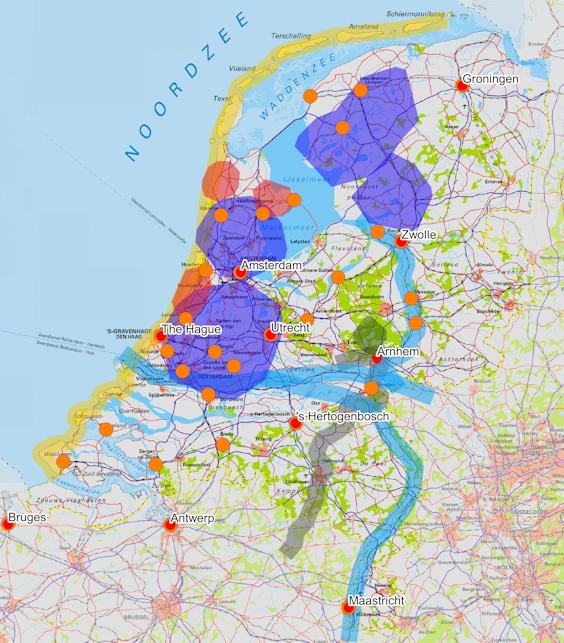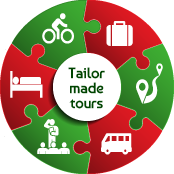Bike tour themes


North Sea coast
- Dunes
- Sandy beaches
- Harbours

Tulips
- Tulips
- Keukenhof flower garden
- Flower parades

Windmills & waterways
- Polders
- Windmills
- Cheeses

River landscape
- Rivers and dykes
- Flood plains
- Bird life

National park
- Woods / forests
- Heaths / moors
- Sand drifts

Historical cities
- Medieval houses
- 'Old masters' art
- City canals

World War II reflection
- Museums
- Battlefield
- War memorials
North Sea coast
Tulips

Combine this tour option with a visit to the famous 'Keukenhof' spring gardens.
Windmills & Waterways
Approximately a-one third of the entire country lies below sea level, and the only place you will find hills is in the south-eastern province of Limburg.
Dutch water-engineering is impressive. Water from the low-lying polders is drained by a network of canals, slow flowing rivers and sluices and is finally pumped away by modern pumping stations, or sometimes older steam-pumps, or even by the famous old Dutch windmills. There are more than 1,000 windmills which have been well-preserved and are still in good working order. It is also possible to visit some of these windmills during your tour.
River landscape
National park
Today the park, covering an area of 5,500 hectares, is a unique blend of forests and woods, shifting sands and heather moorlands providing a sense of isolation that is not to be found anywhere else on the Dutch mainland.. Red deer, wild boar and sheep roam freely. The many cycle paths criss-cross the park and there is almost no vehicular traffic.
The Hoge Veluwe recently renovated its Visitors Centre, as well as the beautiful and architecturally significant Hunting Lodge called St Hubertus. The gem of the park must be the famous Kröller-Müller Museum, containing 278 works by Van Gogh, as well as smaller collections of Picasso and Mondriaan and many others. Around the museum building there is an enchanting garden which houses Europe's largest collection of sculptures with works by Rodin, Moore, Giacometti and many more.
Historical cities
Despite a lack of building materials and swamp conditions, the merchants in the sixteenth century managed to amass unbelievable fortunes, building beautiful mansions with lavish interiors. The wealthier merchants commissioned artists to paint their portraits and so the famous Dutch School was born. Rembrandt van Rijn, Johannes Vermeer and Frans Hals, to name but a few, all belonged to this school.
Dutch artisans making ceramic pottery also found new market for their products. This period of prosperity became known as the Golden Age. Today the illustrious period is still evident in some smaller Dutch cities such as Delft, Gouda and Leiden, as well as in the four main cities: Amsterdam, The Hague, Rotterdam and Utrecht.
Amsterdam is famous for the Rijksmuseum, the Van Gogh Museum, the Anne Frank house, its beautiful canals and of course, its vibrant atmosphere. We recommend you visit the city before or after your cycle tour and take, public transport to get around using the train, tram and bus. The amount of traffic and number of people milling about the narrow streets would certainly not add anything to your cycling pleasure.
The Hague, on the other hand, is more distinguished and dignified as well as being famous for its royal palaces and parliament buildings.
In Utrecht you should explore the city's canals and the unusual pedestrian wharfs, five meters below street level.
Delft owes its name to the world 'delving', digging the oldest canal. The city has links to appealing cultural-historical values such as Delftware, the Dutch royal family and the Dutch East India Company.
From Delft you can easily visit Rotterdam, which was badly bombed during WWII, but has resurrected itself to become an icon of experimental post-war architecture, as well as being one of the largest commercial harbours in the world.
The Hanseatic cities in the central-eastern part of the Netherlands are even older than the cities in the western parts. Most of these towns are situated along the river IJssel. In the 14th and 15th century, they formed a merchant union that lead to enormous prosperity and wealth. You can still sense the rich history of the cities Harderwijk, Elburg, Hasselt, Kampen, Zwolle, Hattem, Deventer, Zutphen and Doesburg.
There are a countless number of places that will be of interest to you. Towns and villages, each with their own personality and uniqueness and of course many, many museums and parks.
World War II reflection
After the successful Allied invasion (D-day) in Normandy, the south of Holland was liberated in the summer of 1944. The Allies developed a paratrooper plan, Market Garden, to seize two bridges in Holland: one in Nijmegen and the other in Arnhem. Although the first objective was reached, second was a disaster. The paratroopers were annihilated by a German Panzer division, the survivors eventually escaping back behind Allied lines. The first months of 1945 were extremely costly for the Dutch. Thousands of people died of starvation in the cities, where the effects of the ever-decreasing food supplies were the most severe.
Finally, in April 1945 the Allied forces were able to push through and Holland was liberated on 5th May; three days before Germany's total surrender. With the arrival of freedom, the Dutch went from the depth of despair to soaring heights of joy. Experiences from WW II are engraved in the collective Dutch consciousness. This manifests itself in a day (4th May) of commemoration of all military and civil victims of war and the remembrance of the tremendous sacrifice of the foreign Allied liberation force.
Each year the end of World War II is celebrated on 'Liberation Day' which is on 5th May. The events and emotions of the dark years of the WWII period are well preserved in many museums, visitors centres and war cemeteries. Their purpose is to show the horrors of that period in the hope that 'this never again' will happen to future generations. Some major battle fields from 1940 and also the area where the 'Market Garden' operation took place are all within easy cycling distance, so that you may wish to include this theme along with your other preferences.







